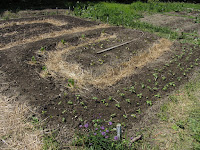For example, some guy interviewed (ooh! that's bad quotation!) said that organic farming was partly created to bring transparency to the agricultural system. Although I had never formulated this thought, I feel comfortable with it... What do you think? Is it reasonable to affirm this? In my personal experience, the event of organic agriculture has certainly brought about a lot of discussions on origins and opening up to where food came from. But was that because it's organic, or was it a mandate a lot of organic producers believed in? The conventional animal farm at the school is certainly very open about its process... Was it just not reaching me before I found an interest in it?
Also, maybe the same guy, or another (!) brought up how choosing to buy organics meant that one had a real impact on preserving life. This point was expressed by Vandana Shiva (I knew of her, so it was easier to remember) as a "moral obligation to be a co-producer of a sustainable, healthy, just, peaceful economy of food". Her choice of words resonate with me. She also added "the moment we are choosing the food we eat, we are supporting the production system". But that ain't just about food... Knowing what's behind our buck is a full time leisure activity. I would like to be more coherent in my spending... But the I fear the consequences... No computer (programs made to last only a certain period of time)... No cell phone (war in Congo)... Already, I don't have to go very far in my research that all of my daily time table in put into question. Anyways, I put that aside for now, but comments are welcome.
The original owner of Stoney Fields (organic yogurt company) had another moral obligation to point out. His company was bought up by Danone (giant yogurt company), yet he said he remained independent after the deal in his decision making. And in that sense, he said small organic companies had the moral obligation to show the way to giant companies. This mandate would foster an 'aggressive commitment' from these big companies, which would 'change the world'. Somehow, I feel uncomfortable with that. 'Big' means a lot of money and profit... To achieve this it seems to me like a lot of travelling needs to be done (for example). All this is done because people live in cities and have an urban lifestyle... I think a more fundamental shift is needed. What do you think? (notice how I'd like comments on this page?)
Vandana Shiva enumerated '3 Big Myths' of the 'vicious industrialized, globalized agriculture':
- Industrial and chemical agriculture (including GMO) produces more food.
- Globalized agriculture is based on competition
- It is self-generating surpluses
The disconnection between what we eat and how it is grown, is partly why we created this garden. Getting educated though practice.
Cheers
Billie





